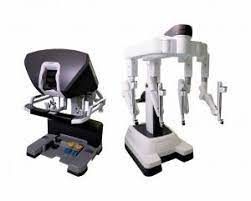Laparoscopic versus robot assisted repair of ventral hernia
Oscar A Olavarria, general surgery resident,1 ,2 Karla Bernardi, general surgery resident,1 ,2 Shinil K Shah, associate professor,1 ,3 Todd D Wilson, associate professor,1 ,3 Shuyan Wei, general surgery resident,1 ,2 Claudia Pedroza, associate professor,4 ,5 Elenir B Avritscher, assistant professor,4 ,5,4 ,5 Michele M Loor, assistant professor,6 Tien C Ko, professor of surgery,1 Lillian S Kao, professor of surgery,1 ,2 and Mike K Liang, associate professor1 ,2
BMJ 2020; 370 doi: https://doi.org/10.1136/bmj.m2480
This study found no evidence of a difference in 90 day postoperative hospital days between robotic and laparoscopic ventral hernia repair. However, robotic repair increased operative duration and healthcare costs.

Recently, a retrospective national database study published by the Americas Hernia Society Quality Collaborative compared the most commonly performed minimally invasive ventral hernia repair techniques: RVHR with intraperitoneal onlay mesh placement and laparoscopic ventral hernia repair (LVHR) with intraperitoneal onlay mesh placement. This study showed a shorter postoperative hospital length of stay with RVHR (0 days in the RVHR group versus 1 day in the LVHR group; P≤0.001) and no differences in safety or clinical outcomes.3 Our aim was to validate these findings by doing a randomized controlled trial to compare the clinical and patient-centered outcomes between RVHR and LVHR. We hypothesized that RVHR, as opposed to LVHR, would decrease days in the hospital up to 90 days after surgery.

This is the first randomized controlled trial comparing robotic versus laparoscopic ventral hernia repair. Among patients undergoing minimally invasive ventral hernia repair, we found no evidence of a difference in 90 day postoperative hospital days between robotic and laparoscopic repair. Furthermore, robotic surgery nearly doubled operating room time and significantly increased the cost of healthcare. Larger multicenter trials are needed before widespread adoption of robotic ventral hernia repair can be recommended.
BMJ 2020; 370 doi: https://doi.org/10.1136/bmj.m2480
This study found no evidence of a difference in 90 day postoperative hospital days between robotic and laparoscopic ventral hernia repair. However, robotic repair increased operative duration and healthcare costs.

Recently, a retrospective national database study published by the Americas Hernia Society Quality Collaborative compared the most commonly performed minimally invasive ventral hernia repair techniques: RVHR with intraperitoneal onlay mesh placement and laparoscopic ventral hernia repair (LVHR) with intraperitoneal onlay mesh placement. This study showed a shorter postoperative hospital length of stay with RVHR (0 days in the RVHR group versus 1 day in the LVHR group; P≤0.001) and no differences in safety or clinical outcomes.3 Our aim was to validate these findings by doing a randomized controlled trial to compare the clinical and patient-centered outcomes between RVHR and LVHR. We hypothesized that RVHR, as opposed to LVHR, would decrease days in the hospital up to 90 days after surgery.

This is the first randomized controlled trial comparing robotic versus laparoscopic ventral hernia repair. Among patients undergoing minimally invasive ventral hernia repair, we found no evidence of a difference in 90 day postoperative hospital days between robotic and laparoscopic repair. Furthermore, robotic surgery nearly doubled operating room time and significantly increased the cost of healthcare. Larger multicenter trials are needed before widespread adoption of robotic ventral hernia repair can be recommended.
